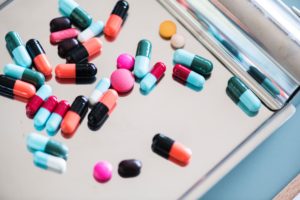Dr. Oz sounded the alarm about unsafe levels of arsenic in apple juice a couple of months ago. Now Consumer Reports is jumping on the bandwagon.
In September, Dr. Oz reported to viewers and followers that he had tested 50 brands of apple juice and found that they all contained high arsenic levels. Consumer Reports conducted its own investigation by testing 88 samples of apple and grape juice. It found that 10 percent contained arsenic levels that exceed the 10 parts per billion allowed for bottled water, as dictated by the Food and Drug Administration, and that 25 percent had lead that exceeded the 5 parts per billion allowed for bottled water. The FDA does not have standards for arsenic or lead levels for fruit juces, so the bottled water standards are applied. Brands tested include Mott's, Welch's, Walgreens and Apple & Eve and Great Value.
The concern is not the overall levels of arsenic, but the levels of inorganic arsenic which is a carcinogen to humans. Here is how Consumer Reports describes arsenic and the difference between its forms:
What exactly is arsenic?
Arsenic is a metalloid, meaning it shares properties of metals and non-metals. It can be found in rock and soil, with trace amounts in some areas and heavy concentrations in others. Keep in mind that “naturally occurring” arsenic does not translate to “harmless.” On the list of 275 hazardous substances at toxic waste sites, the federal Agency for Toxic Substances and Disease Registry ranks arsenic as number one, based on risks to people living around those sites.When arsenic leaches from such rock formations into groundwater, it can contaminate water used for drinking and irrigating crops. But arsenic has also been used for many commercial purposes. For decades arsenic-containing insecticides were widely used in orchards, vineyards and cotton fields. Even though the use of lead arsenate insecticides was banned in the U.S. in the late 1980s, arsenic remains in the soil, so past use of those pesticides can lead to contamination of fruit now grown in those orchards. Concerns also have been raised about the possible continuing use of arsenical insecticides in other countries, including China, which now supplies the majority of apple concentrate used in the U.S.
Arsenic also has been an ingredient in a wood preservative, chromated copper arsenate (CCA), used in pressure-treated lumber commonly found in outdoor decks or children’s playground equipment. Though CCA was banned for virtually all U.S. residential use in 2003, it is still used industrially and can even contribute to arsenic in groundwater when recycled as mulch. Through all of these routes and more, arsenic can enter the food chain.
What’s the difference between organic and inorganic arsenic?
Arsenic can combine with other elements to create compounds that are divided into two forms: inorganic arsenic compounds and organic arsenic compounds. When used to describe arsenic, the word “organic” has nothing do with the term that appears on labeling for foods that meet USDA certified organic standards.When arsenic binds to elements such as sulfur, oxygen and chlorine, it forms inorganic arsenic compounds. Inorganic arsenic is a known human carcinogen and is the form found in drinking water, lead-arsenate insecticides and CCA.
Organic arsenic compounds are formed when arsenic binds to molecules containing carbon. Fish can contain an organic form of arsenic called arsenobetaine, which is generally considered non-toxic to humans. But much less is known about the health effects in humans of other types of organic arsenic, and products containing them have raised enough concerns that they are no longer being sold. EPA in 2006 took steps to stop the use of herbicides containing organic arsenic because of concern about their potential to transform into more toxic inorganic arsenic in soil and then contaminate drinking water.
The Food and Drug Administration disputes the finding by Dr. Oz and Consumer Reports, and insists that fruit juice on grocery store shelves is safe for human consumption. From the agency website:
The U.S. Food and Drug Administration (FDA) has been testing for arsenic in apple juice and other fruit juices for decades as part of FDA programs that look for harmful substances in food. We continue to find the vast majority of apple juice tested to contain low levels of arsenic. For this reason, FDA is confident in the overall safety of apple juice consumed in this country.
What does all of this mean for consumers? It means be very careful, particularly when it comes to what you feed your children. Some in the medical community believe that any level of arsenic in fruit juices is unacceptable and should be avoided. If you determine that you fall in that camp, put fruit juices on the list of things to avoid until further notice.

Bret Hanna of Wrona DuBois in Utah, focuses exclusively on litigating plaintiffs’ medical malpractice and catastrophic personal injury cases. He has represented clients in state and federal courts, in mediations, and in administrative proceedings in Michigan and Utah since 1991.











2 Comments
Jennifer Greene
Bret, bravo on sharing information about arsenic. I just wish the spotlight were being put on chicken too, as it has even more arsenic than apple juice. (Reason: because arsenic is actually put in the chickens' feed.) See Dr. Greger's column at http://nutritionfacts.org/?p=4424. (I recommend NutritionFacts.org as an excellent site for nutrition info. It's non-commercial, and it provides sources for all research cited.)
Ida Macchia
Is there arsenic in the fruit and vegetables we eat raw or cook and serve our families? If yes, which ones should we avoid? Who can give me this information? Are there any juices not laced with arsenic? I am expecially interested in berries, dried fruit, greens such as collard, broccoli rabe, spinach, lettuce, escarole, herbs, etc.
Comments for this article are closed.